#greek resistance
Text
Incredibly important pictures from the Greek resistance against the Nazi Occupation of Greece in WWII

ELAS partisans. The Greek People's Liberation Army (ELAS) was the largest and most significant of the military organizations of the Greek resistance.

Ares Velouchiotis was the most prominent leader and chief instigator of ELAS and the military branch of the National Liberation Front (EAM).

When you're both a priest and a partisan.

Voting. EAM's women had equal rights and were invaluable to the Liberation Front. The political right of women to vote would be officially recognized by the Greek state about 10 years later, in 1952.
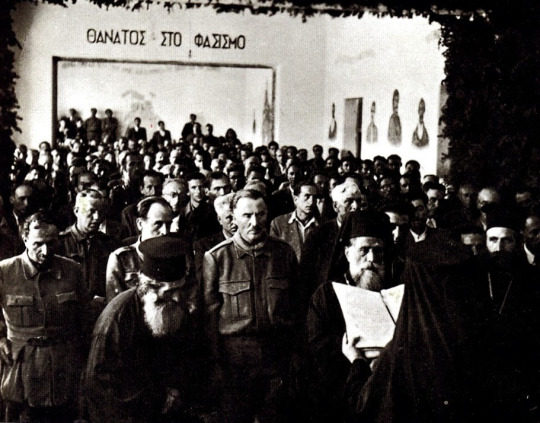
"Death to fascism"
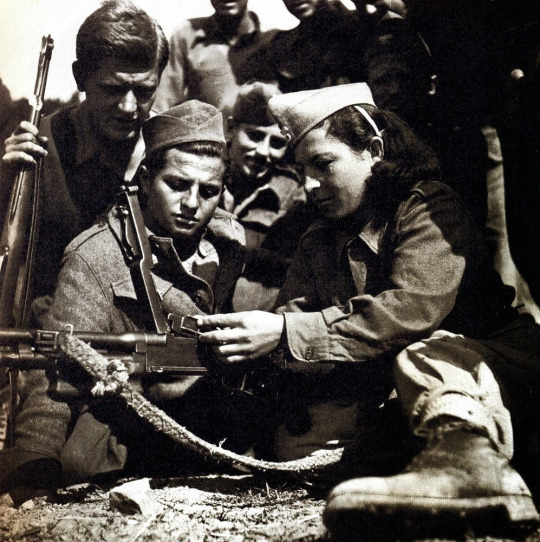
Learning to use the firearms.

Partisan Titika.

Partisans. PEEA, the government formed by EAM, was also called "the mountain government", as it operated from the mountains, so that its people and their activities would not get as easily detected by the Germans.
All photos by Spyros Meletzis (1906-2003)
131 notes
·
View notes
Text

Greek Resistance
37 notes
·
View notes
Text

EXECUTING A TRAITOR -- IT'S A DIRTY JOB, BUT SOMEBODY'S GOTTA DO IT.
PIC INFO: Spotlight on a film still of the late, great Greek actress/singer Irene Papas (1929-2022), portraying a local resistance fighter, Maria, in the 1961 action/ adventure/war film, "The Guns of Navarone," directed by J. Lee Thompson.
Source: www.virtual-history.com/movie/film/8816/the-guns-of-navarone.
#The Guns of Navarone#Guns of Navarone#Irene Papas#IrenePapas#IrenePappas#The Guns of Navarone 1961#Irene Pappas#Action/Adventure#Cinema#60s Cinema#60sMovies#WorldWarII#WarMovies#Sixties#60s#1960s#Resistance Fighter#Greek Resistance#OldHollywood#WWII#Greek Actress#MovieStills#FilmStills#Action/Adventure Movies#Resistance#Actress#GreekResistance#GreekActress
0 notes
Text

Greek resistance fighters prepare to advance on a German held Police Station during a civil uprising - Athens 1944
#world war two#1940s#worldwar2photos#history#ww2 history#ww2#wwii#world war 2#ww2history#wwii era#athens#greece#1944#resistance#Greek
147 notes
·
View notes
Text

Raya Lucaria Ancient Greek AU
Sellen and her apprentices (belong to SilveRain and ashuldur)
#elden ring#sorceress sellen#sellen#tarnished#raya lucaria#soulsborne#i know that greek architecture was a way more colorful centuries ago#just couldn't resist my love for ruins#my art
796 notes
·
View notes
Text
*scuttles in and drops this at your door* jmart dnd au anyone??? anyone???
anyway trying to improve on backgrounds and I think this turned out really well as I haven't drawn a proper forest background before, its a little cluttered but alas.
alt w/o eye below the cut
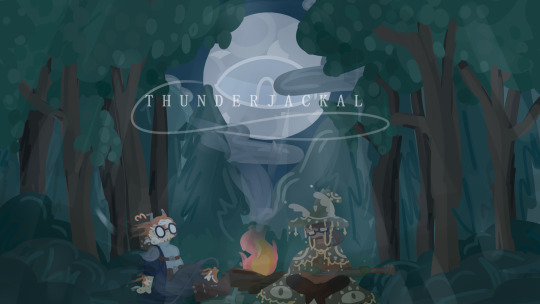

#jmart#jonmartin#teaholding#tma jon#jon sims#jonathen sims#jarchivist#martin blackwood#tma martin#tma#the magnus archives#magpod#the magpod#thunders funky art#thinking this is set in s5#Martins a wind genasi?? idk if they exist (i completely forgot genasi's have differently coloured skin whoops) (they also dont have tails O#horns but sshh its finne)#he's also a bard but not like instrument bard more like ancient greek bards like orpheus where his voice + poetry is his instrument#Jon is a elf/human idk you decide (half elf/?? maybe) and a warlock#but i think he pretends to be a wizard#BECAUSE THE ASETHETIC#moth Jon got to me guys#i couldn't resist#dnd au#dnd#tma fanart
53 notes
·
View notes
Note
For the gods that people like simping for, I kinda get it. I don't desire any of them carnally, but they're very pleasing to look at.
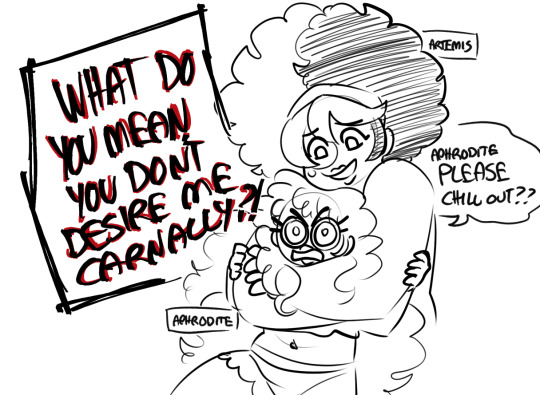
#greek mythology#my art#artemis#aphrodite#i know this was regarding hades but i couldnt resist#and i havent drawn these two in awhile
172 notes
·
View notes
Text

"From another point of view", 2017, oil on wood, 50x50 cm.
'The death has been announced of prominent contemporary Greek artist Stelios Faitakis, who was acclaimed for his allegoric paintings that combined Greek Orthodox iconography with street art.'
58 notes
·
View notes
Photo

Θαρσείν χρη, τάχ’ αύριον έσσετ’ άμεινον. Eλπίδες εν ζωοίσιν, ανέλπιστοι δε θανόντες.*
- Theocritus
You need to have courage, because tomorrow will be better. While there's life there’s hope, and only the dead have none.*
My ex-regiment proudly traces its lineage back to the Glider Pilot Regiment which spearheaded British airborne forces to take Pegasus Bridge on D Day 6 June 1944. During my service I had the privilege to travel there and take part in the commemorative ceremonies whenever D Day came around. I loved listening to the stories of some of the surviving veterans and also some of the local French too. The British taking of Pegasus Bridge - re-named partly after the emblem of pegasus of airborne forces - was one of the stand out events of the first days of D Day by British forces.
Airborne landings in the British Sector were targeted mainly at the Orne River/Caen Canal crossings and the artillery installations of the Merville Battery. The strategic purpose was to secure river crossings for the beach break-out and to reduce enemy defences.

At 00:16 hours on 6th June parachutists and gliders from the Airborne Division, consisting of D Company of the Oxfordshire & Buckinghamshire Light Infantry, began to land east of the River Orne and the Caen Canal.
The small force of 181 men was commanded by Major John Howard and joined with a detachment of Royal Engineers who landed at Ranville-Benouville in six 28-men Horsa gliders. Having taken off from Dorset, the gliders were towed across the Channel by Halifax Bombers. With perfect navigation and piloting skill, the gliders landed on time and on target within few yards of each other.
Major Howard’s glider landed within a few feet of the canal bridge. The bridge was captured after a fierce ten minute fire fight, the action all over by 00:26, a full six hours before the beach landings.
But the success of the mission was also down to intelligence gathered by locals and passed onto British intelligence through the French resistance channels.
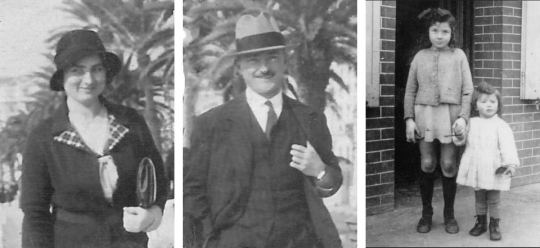
One of these was Georges Gondrée and his wife, Thérèse. Georges and Thérèse moved to Bénouville where they bought a small café in 1934 on the shore along the Bénouville Bridge, called Café Gondrée. During the Invasion, they had three small daughters: Georgette, Arlette, and the newborn Françoise.
The family certainly hated the German occupation. Among other things, they refused to allow their café to serve as a billet for German soldiers. But they went further by joining the French resistance at great danger to themselves.
As the war progressed, the more risks and dangerous activities they undertook against the Germans. Thérèse, who grew up in Alsace, knew quite a bit of German. Local residents did not like her Germanic Alsatian accent but she took care to keep her knowledge of German secret from the German soldiers themselves. This often helped her to eavesdrop on conversations of the soldiers and then pass on important information to the resistance through her husband, Georges. There were a few times when they were nearly caught but somehow they survived.
The information gathered by the Gondrée family contributed greatly to the insight of Major Howard and his troops to better assess the defensive positions around the bridge. Among other things, Thérèse was able to pinpoint the exact location of the detonator that was supposed to have detonated the bridge during the attack. Georges was also known to British intelligence and even Major Howard had heard his name mentioned during the planning of the invasion itself.
The importance of the family’s contribution to the success of the British attack can also be seen from an example during early May 1944. When Field Marshal Erwin Rommel came to inspect the bridge, he had given the order to place an anti-tank gun beside the Bénouville Bridge. Within two days Major Howard had been informed that a new structure was being built along the bridge and within a week Georges’ observation had helped to confirm both its function and exact location.

So, just 90 minutes after taking off from RAF Tarrant Rushton in England, Major Howard was able to send the code words “Ham and Jam”, indicating that both bridges had been captured. In this early action of D-Day, the first house on French soil was liberated, and the first British soldier of the Normandy Invasion was killed in action: Lieutenant Den Brotheridge.
It was No. 1 Platoon which knocked out a machine gun position firing from the bridge and rushed across to capture the far side, firing from the hip and lobbing grenades during the charge. Lt. Brotheridge was mortally wounded by gunfire as he made a grenade attack on a second machine gun position. The bridge had been prepared by the enemy for demolition, although the Royal Engineers removed the unset charges.
Within half an hour of the bridge being taken, 6th Airborne parachutists landed to provide reinforcement. The Ox & Bucks were reinforced half-an-hour after the landings by 600 men of 7th Battalion, the Parachute Regiment who were the relieving force to bear the brunt of German counter-attacks to the west of the Caen Canal throughout the 6th of June.
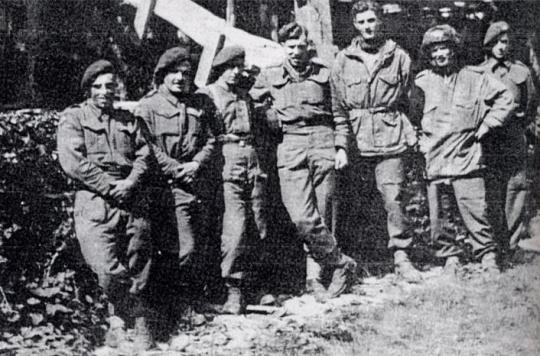
The Battalion distinguished itself in holding a wide bridgehead around ‘Pegasus Bridge’ against constant enemy attacks which were often armour supported. In particular the “A” Company, based in the nearby village of Bénouville, suffered the most severe fighting and were eventually cut off from the remainder of the 7th Battalion.
The first relief in force was from 6 Commando, led by the commander of the 1st Special Service Brigade, Lord Lovat, who arrived to the sound of the Scottish bagpipes, played by the 21–year-old so-called ‘Mad Piper’, Private Bill Millin.
The remnants of the 7th Battalion’s “A” Company continued to hold out until 9:15pm on the 6th June when British infantry, in the form of the 2nd Battalion The Royal Warwickshires, arrived from the invasion beaches and secured Bénouville, and so allowed the evacuation of “A” Company’s many wounded.
In honour of the distinctive emblem of the Parachute Regiment, the distinctive bridge at Benouville was renamed and will forever be known as “Pegasus Bridge”.

Arlette Gondrée being kissed by two veterans who remember her parents.
Over the years, many thousands of pairs of British boots have crossed the threshold of the Café Gondrée. General Montgomery in 1945, veterans paying tribute to fallen comrades and numerous members of the Royal family. Arlette Gondrée, the daughter of Georges and Thérèse, still recalls with crystal clarity the very first occasion a British soldier arrived at the cafe on the night of June 5, 1944, when she was just four-years-old, cowering with her family in the basement during the start of the D-Day invasion.
Commemorating the landings in 1945, General Montgomery visited the Café Gondrée Pegasus Bridge, renamed after the winged emblem of the British 6th Airborne Division, with some widows of the soldiers lost in the Normandy campaign. Georges produced some of the vintage champagne he had hidden, including a 1926 Pouilly-Fuissé.
Over the ensuing years, the family never ceased to celebrate their liberation. “Daddy would make a large U-shaped table in the café and we would eat together as a happy family, and very, very thankful to the British for what they did for us. And that remains so to this day.”
Life was hard for years, made worse by rationing. The effect of the ordeal on the girls was subtle, but not invisible: in November 1944, the Red Cross visited and told Arlette if she stopped biting her nails, they would give her a real doll to replace her cardboard toy. The café didn’t open properly again until June 1945.

To this day, Mme Gondrée keeps her “little house” as a shrine to the British Airborne forces that liberated her family. She has said that she always felt honoured to have the privilege of being custodian of the memories of that fateful day.
Photo: Major John Howard is flanked by George Gondrée and Lt. David Woods raising a glass to the successful capture of Pegasus Bridge that day.
#theocritus#greek#classical#quote#D Day#DDay#British army#second world war#pegasus bridge#glider pilot regiment#gondree cafe#georges gondree#therese gondree#arlette gondree#major john howard#lt david woods#military history#french resistance#history#courage#bravery
60 notes
·
View notes
Text
My AP environmental class had a slideshow vaguely mentioning old-timey healing stuff including herbs and how people used to use them as medicine.
Teacher: … actually, most of the “witches” that have been killed throughout history were likely just healers.
Classmate I’m vaguely familiar with: Do you think witches are real, Mr. [name]?
Me: well, I’m right here, so.
complete silence in the classroom for a second while everyone absorbs that
Teacher: Well, there you go! :D
#I’m a Loki devotee I couldn’t resist the urge to cause a little chaos hehe >:]#The teacher is actually like in the top ten human beings btw#A few years ago I’d changed my google pfp to have the trans flag and he asked if I had a preferred name#Which no other teacher did because florida#And he’s proceeded to use that name for me in class ever since#Which then made me more confident in talking to my other teachers about it#So yeah#paganism#pagan witch#celtic paganism#hellenic pagan#greek paganism#witchblr#witchcraft#witch community
12 notes
·
View notes
Text
Famous Greeks who fought in the Greek resistance against the Axis Powers in WWII
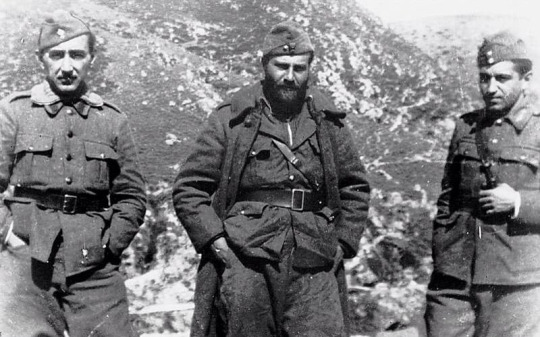
Odysseus Elytis (middle): The nobelist poet served as a second lieutenant in the Greek frontline. After a few months he contracted a severe case of typhus, so he had to be hospitalized. He recovered and a lot of his future poetic work was inspired by the war.
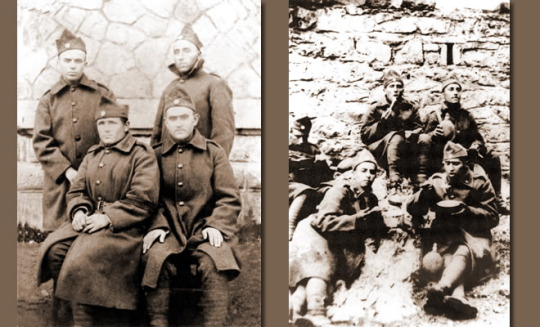
Nikephoros Vrettakos (standing on the right in the first picture): The poet and author fought in the frontline in 1940 and almost got killed in Klisura. After his regiment was dissolved, he joined EAM / ELAS (Greek People's Liberation Army) and continued fighting until 1944.
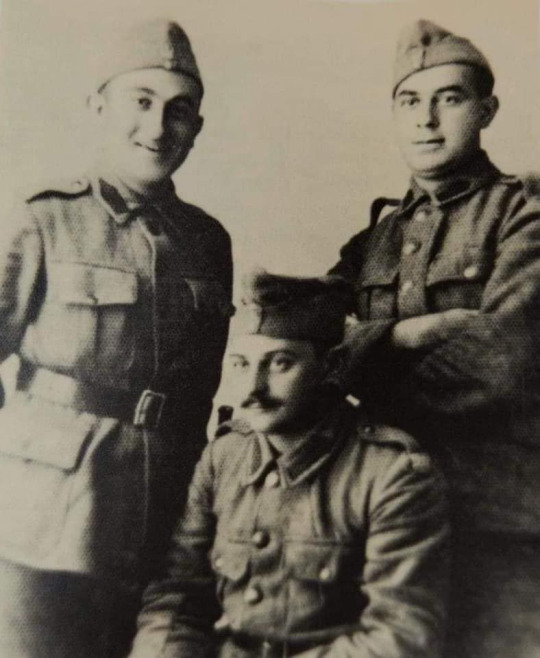
Nikos Kavvadias (seated): Well known for his poetry inspired by his adventures in the sea, the sailor rarely wrote prose, but when he did, it was usually inspired by his days in land fighting in the war.
Many other poets also fought in the war. Ángelos Sikelianós volunteered to join the army, but he was rejected because he was 56 years old at the time.
Rebetiko and Laiko musicians and composers Markos Vamvakaris and Vassilis Tsitsanis also went to war. Tsitsanis entrusted his buzuki instrument with his mother and promised to return to take it back.

Painter Yannis Tsaruhis also fought in the Albanian frontline (Italy invaded Albania and then marched from Albania into Greece, Greece halted them there and then counterattacked, pushing the Italian forces back, which is why a lot of the war during 1940-1941 took place in the Albanian mountains). Tsaruhis heard that a soldier had a vision of Virgin Mary. He immediatedly made this religious icon, using a kipper can as a canvas and he named it "Η Παναγιά της Νίκης" (i panayá tis níkis, the Blessed Virgin of Victory). The paint had not even dried before a rumour was spread in the camp that the icon was supposedly miraculous.
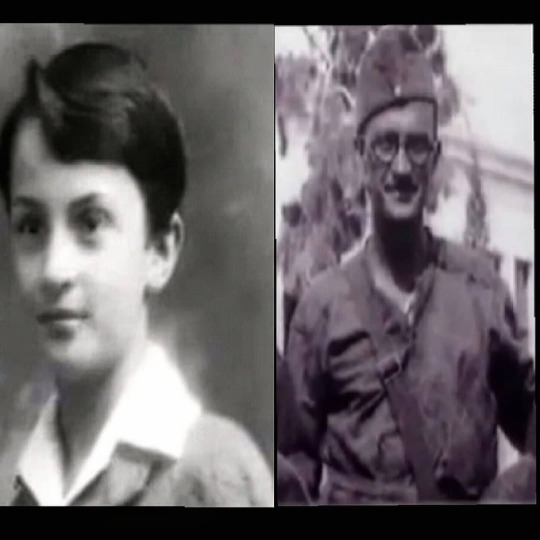
Comedian Dinos Iliópulos, was a Greek of Alexandria, born and raised in Egypt. He completed his millitary service in Greece, even though he was an expat , so it was entirely optional for him. He had returned to his home in Egypt for just one day after finishing his service, when he heard of the bad news. He left immediately, returned to Greece and joined the army.
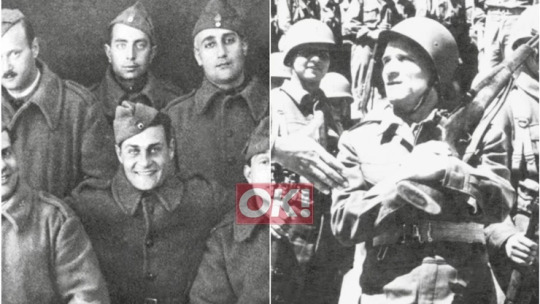
Lambros Konstandaras (centered in the left picture): the great actor volunteered to join the army and fought in the frontline. At some point he was severely injured in the head and the hip. He was rescued by the aforementioned poet Odysseus Elytis! After his recovery, he insisted on returning to the battlefield, but he was prevented from doing this. He was suffering from his wounds for the rest of his life, although his vibrant charisma and talent in cinema and theatre never allowed anyone to see this.
Kostas Hatzichristos (right picture): the hysterical comedian originally dreamed of a military profession, so when the war broke out, he joined the army and fought passionately. However, his days in the army were crazy. He was in the northern front and soon his legs developed frostbite. At some point he was sent to serve in a military hospital. Next to it was a cafe owned by an Albanian man and his sister Orhana. Hatzichristos, a notorious womanizer, fancied Orhana and provided supplies to her constantly and made her other favours as well. At some point Orhana disappeared. Hatzichristos found out she was collaborating with the Italians and was giving them all the supplies he was providing her! He became the target of a lot of mockery in the Greek camp. He was moved to regiments on the rear and then he had a lieutenant who just did.not.like.him and bullied him constantly. Once, Hatzichristos stumbled upon Italian soldiers trying to flee during his patrol. The lieutenant screamed at him to shoot them but Hatzichristos saw how young they were and how they were begging for mercy by crying out “Fratello, fratello” (brother in Italian) and felt sorry for them. He did not obey the lieutenant's order. The lieutenant was furious. Hatzichristos fetched them in front of him and said: "You kill them, since you are the tough guy". Hatzichristos always had a way to deliver lines and the lieutenant broke in laughter. He was so amused that he agreed to spare the lives of the Italians. He knew that an Italian regiment would pass from that point in a few hours, so they tied the two Italians in a tree, placed a little canned food next to them and left them there to be found by their own people once they passed.
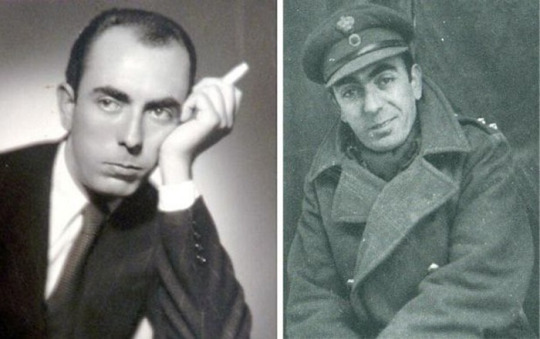
Famous movie and theatre actor Dionysis Papayannópulos participated in important battles in extreme conditions in the mountains. He said that the battles lasted so long that when they ran out of bullets, they would keep fighting with sticks and stones. During the Axis occupation of Greece, Papayannópulos resumed his job as an actor in the theatre. One night, Max Merten, the Kriegsverwaltungsrat of the occupational forces in Thessaloniki, attempted to meet Papayannopulos at his dressing room in order to congratulate him on his performance. The actor refused to open the door and receive him. Merten was responsible for the deportation of the 50,000 Jews of Thessaloniki.

The great theatre actor Manos Katrakis (center) fought in the frontline and saw his commander commit suicide before his eyes when they were caught and disarmed by the enemy.
Sources:
Eleftheros Typos, through Lavart
thessalonikiartsandculture.gr
OK!
Spartorama
#greece#europe#history#world war 2#world war ii#october 28th#greek resistance#greek history#greek people#famous greeks#ww2#wwii#tw war#tw suicide mention#tw long#tw long post
35 notes
·
View notes
Text
i’m between hephaestus and nemesis for p.jo au by the way
#technology forges and fire…. balance retribution and vengeance…. yeah!#i have reasons for both so i have to spin the potential around even more but ohh i’m thinking about it#…… his human parent is still william by the way. yes either way. i said so. it’s greek mythology when there’s a will there’s a way-#ITS RELEVANT I NEED HIM THEREBDKSHFKF#hephaestus is lowkey henry core william could have a type the world just isn’t ready for that yet /hj#also just. aughh i was resisting the urge but ever since the movie novel said mike likes building things..want to snatch it#⁂ ・゚: i was looking for a job‚ and then i found a job‚ and heaven knows i’m miserable now ➛ ooc
11 notes
·
View notes
Text
doomed by the generic conventions of the local christmas panto
#or how resist his fate’s prevailing course?#silly post in the fate tag real forever#doomed by the fact that the world is not a place where you can be a good person#<- thank you for predictive text. fun!#also. adjacent to this is antigone the musical undooming antigone from the generic conventions of greek tragedy via a turn towards the#generic conventions of. comedy but it did have quite a pantomime flavour#marnie if you see this sure antigone survives but what’s the vibe of being trapped in a tonally different yet similarly rigid genre#beeps
12 notes
·
View notes
Text
Ok, look, I know we’re all supposed to hate Zeus…



HOWEVER 👀💦💦💦
#overwatch#queen of junkertown#junker queen#zeus#greek mythology#I don’t think I have the strength to resist#i’m down horrendous#i am dehydrated
45 notes
·
View notes
Text
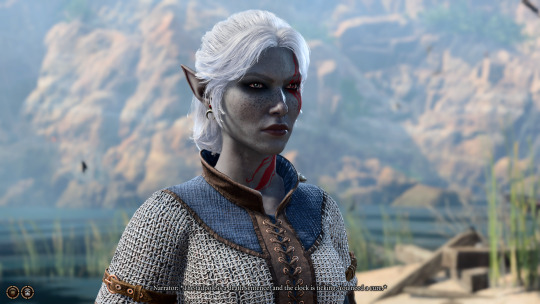



Have to share my drow elf cleric with the tumblr people because I am obsessed with them
#baldur's gate 3#they're called melpomene#named after the greek muse of tragedy#they worship eilistraee#and are trying their best to be a good person#also fucking astarion because they can’t resist the sad vampire man
12 notes
·
View notes
Text
Also Ganymede smooching Zeus after he's gifted him a
rooster. :)
Like this:

#greek myth thoughts#ganymede#zeus#I had to work VERY HARD to resist adding a certain word in strikeout#you don't know how brave I was being about it
40 notes
·
View notes